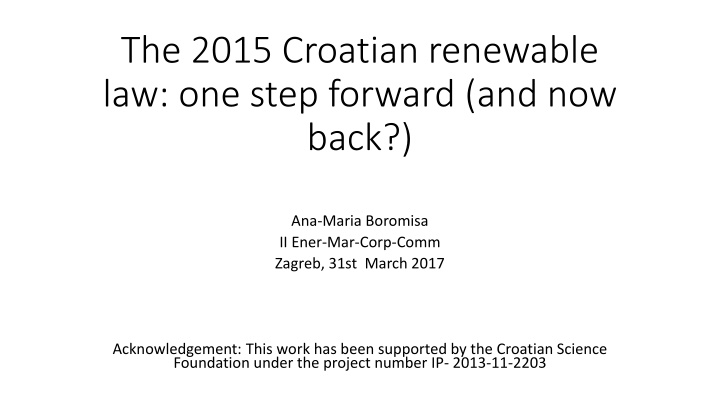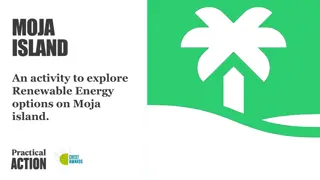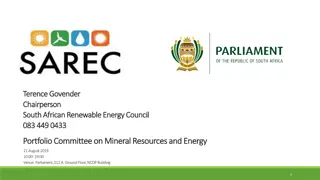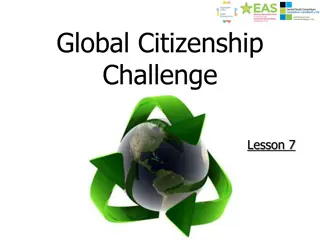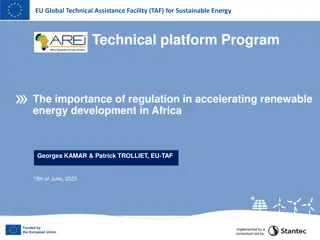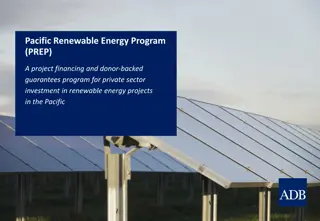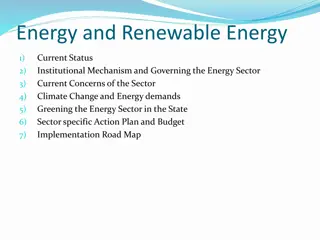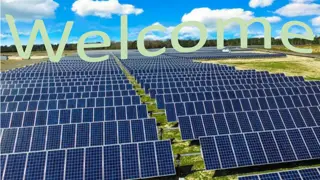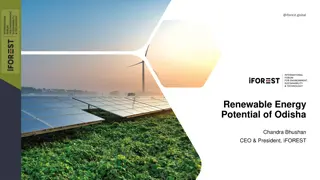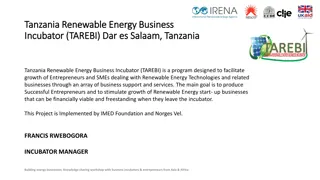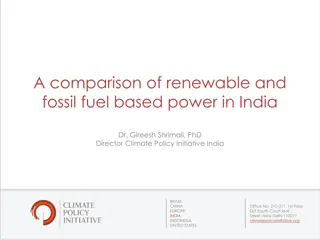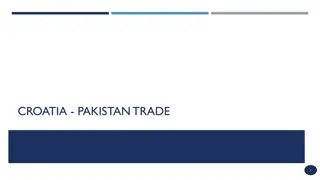Development of Renewable Energy Policy in Croatia: A Comprehensive Overview
The article traces the evolution of renewable energy policy in Croatia from 2001 to 2015, highlighting key milestones such as the establishment of energy laws, market operators, and EU alignment efforts. It discusses the shift in support mechanisms and the implications of the 2015 Renewable Energy and High Efficiency Cogeneration Act on investor confidence. The rapid legislative procedure before elections and the need for EU compliance are also noted.
Download Presentation

Please find below an Image/Link to download the presentation.
The content on the website is provided AS IS for your information and personal use only. It may not be sold, licensed, or shared on other websites without obtaining consent from the author.If you encounter any issues during the download, it is possible that the publisher has removed the file from their server.
You are allowed to download the files provided on this website for personal or commercial use, subject to the condition that they are used lawfully. All files are the property of their respective owners.
The content on the website is provided AS IS for your information and personal use only. It may not be sold, licensed, or shared on other websites without obtaining consent from the author.
E N D
Presentation Transcript
The 2015 Croatian renewable law: one step forward (and now back?) Ana-Maria Boromisa II Ener-Mar-Corp-Comm Zagreb, 31st March 2017 Acknowledgement: This work has been supported by the Croatian Science Foundation under the project number IP- 2013-11-2203
Development of renewable policy in Croatia 2001: the first package of energy law Use of renewable energy interest of Republic of Croatia 2002 the Energy Strategy 2003: Establishment of the Environmental Protection and Energy Efficiency Fund 2004: the new set of energy laws 2005: establishment of market operator HROTE 2006: Croatia joined the Energy Community; EU accession negotiations started
Development contd 2007: Financial incentives: feed in-tariff; 14 years : depending on technology and size of power plant 2007-2016: 3 tariff systems (OG 33/07, 63/12 i 133/13 ) 2009: new Energy Strategy 2020 goals: 20% of renewable in final consumption 2020 35% in production of electricity, 10% in transport, 20% in heating and cooling
Within the EU 2012-2013: new round of alignment with EU Introduced the certificates Guarantee of Origin Center for monitoring business activities and investment in energy sector established Renewable energy action plan until 2020 (not published in the Official Gazette); differnt projections than in Energy Strategy 2014: new tariff system reduced support for solar and wind biogas, biomass and small hydro almost the same
2015 Revoked regulation:minimum share of RES by 2020 (18% in 2013) signal to investors: no new support The Renewable Energy and High Efficiency Cogeneration Act (Sept. 2015) Finalise transposition of the EU acquis (renewable energy - Directive 2009/28/EC and the energy efficiency directive -Directive 2012/27/EC) State aid? Gradual introduction market-based instruments Replacement feed in with market premium model
Timing and preparation pushed through Parliament at its last session before the elections an expedited procedure: the government initiated the legislative procedure on September 1, and the law was adopted on September 10 Government s amendments (on September 9), including a 20% reduction of the regulated price suppliers have to pay for renewable energy in 2016. Explanation: the need to (finally) comply with EU legislation, Entry into force: January 1, 2016, with some provisions only entering into force on January 1, 2017. Elections November 8th The bidding process and ceilings: implementing regulation (end January 2016).
2016 1st January: entry into force of new law Existing contracts in force, procedures started in 2015 under the old rules concluded in 2016: 109,411 kW 1 Hydro power plant 130 kW, 3 biomass 1584 kW, 8 Biogas:7700 kW, Cogeneration 100.000 kW Procedures missing: Regulation on quotas incentivising generation of electricity from renewables; Rulebook on renewbales and high efficient congeneration, State aid programme
Quota until 2020 (TS 2015, OG 100/2015) TYPE OF RES TECHNOLOGY QUOTA (MW) Hydro 10 MW 35 Geothermal 30 Wind 744 Biofuels Biomass from forestry, agriculture and waste 120 Biogas including waste gas and gas from water treatment plants 70
Contracts activated 2016 (kW) Pending contract (kW) Installed capacity (kW) Number o TECHNOLOGY. 18 1219 11 12 26 6 0 34200 5496 898 1370 8502 100000 326000 3892 4164 93972 25785 0 10000 Wind Solar Hydro Biomass Biogas Cogeneration Geothermal 412.000 49.479 3.885 25.955 30.435 113.293 0 1 0 0 Waste gas PP 3.000 E. Gas Waste water Total 1 2.500 1294 150.464 463.813 640.547
Installed capacity (640 MW)
Incentives in 2016 No of contracts 1399 (1294 active) 1 expired (Ravne Wind Power Plant) Installed capacity 640.547 MW Production 1,725,935 MWh 11 % 15,551,386 MWh Collected fee/surcharge on bill 514,699,654.95 kn Sale 724,893,107.82 kn Total collected 1,239,592,762.77 kn Paid 1,546,551,464.76 kn Difference -306.958.701,99 kn
Financial results 2007-2016 kn Eur, million Collected fee (surcharge, currently 0,035 kn/kWH) 2,243,813,985 299 Collected (suppliers obligation) 2,474,050,484 330 Total collected 4,717,864,470 629 Paid: feed in tariff 4,625,133,309 617 Balancing costs 60,275,520 8 Service (suppliers), 1.5% PPC 3,262,279 0.4 Total cost 4,688,671,110 625 29,193,359 3.9
Planned (law)/implementing regulations Quotas and bidding procedrue: by the end January 2016 starting in 2017, producers of renewable energy will be subject to balancing responsibilities A special (simplified) regime will be provided for small installations (up to 500kW), and their suppliers will have to take on the electricity-surplus they produce. competitive procedures for the use of state property for renewable energy installations. All the potential investors will have to go through a tender procedure to obtain a right to build or land a lease agreement. the implementation of the new act will create new jobs and require additional funds in the state budget.
New projects 2016 Type of technology Number of projects Planned capacity, kW Biomass 4 1,374 Solar 1 27.3 Total 5 1,401
2016 National Reform Plan 2016 Adoption of new energy strategy Adoption of new Renewable Energy Action Plan Adaption of implementing regulations for Renewable Energy Sources and Highly Efficient Cogeneration Law Merger HERA and HROTE The Low Carbon Development Strategy until 2030 with view until 2050 (planned 2015, postponed 2016...) Government adopted Regulation changing The Renewable Energy and High Efficiency Cogeneration (29 December 2016, entry into force 31 December 2016, OG 123/2016) extension of obligation to buy electricity from eligible producers until 31 December 2017, 0,42 kn/kWh Postponed EKO balancing group operational by 1st January 2018 Derogation of Article 40 (defining sale of electricity from eligible producers)
Current information Programme of the government 2016-2020 2050 Energy strategy: security of supply, competitive prices, including renewables, coherent with Low carbon development strategy 2030 Specific goals: Improved security of oil suply Improved security of gas supply RES employment: 1759 jobs Decreased VAT (25-13%); proposal to introduce excises 10-15% (mid-February 2017) Increasing fee from 0.035 kn/kWh to 0.075kn/kWh? Proposal in pubic consultation Considers EU guidelines on state aid Considers Renewable energy action plan until 2020 Some questions: discrimination ? Is it genuine market? Is it actually possible for new entrants to gain contracts under fair terms? .
Challenges Problems: feed in tariff, supportive policies State aid rules? Commission's Guidelines on state aid for environmental protection and energy 2014-2020 from January 2017 aid is granted on the basis of a clear, transparent, non- discriminatory competitive bidding process open to all producers of renewable electricity Excise duties on existing projects? Financing? Banks including HBOR? Enhanced bankability- reduced cost of capital// reversing trend Transposition of EU acquis: 2016 plan, 2017 plan? Law: Zakon o postupcima za naknadu tete zbog povreda prava tr i nog natjecanja (Adopted by the Government 27.02.2017; on in the 1st reading in the parliament 17.03.2017 ) By-laws : RES implementation not listed (as of 21 March 2017)
